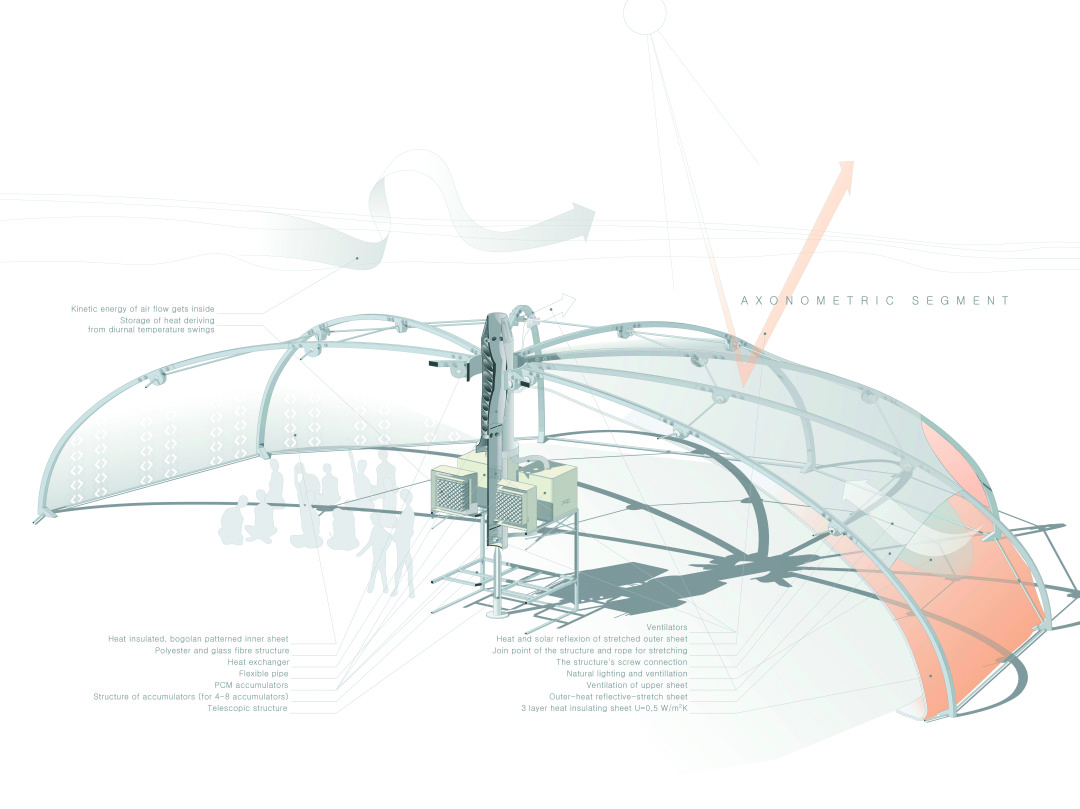
Being directly involved in a situation is a twofold circumstance: if from one side you are in the position to have experienced the matter, and to know what you are talking about, on the other hand the nature of your involvement affects your judgement, reducing or even cancelling the critical distance between the object of the discussion and yourself.
In the case of the Holcim recognition awarded to a project located in Bassikonou, Mauritania [Holcim Award Acknowledgement, White Canvas, Bassikounou, Mauritanie / Mauritania, 2018 / ArchSus Group [Attila Szabadics and Mónica Rácz]], the controversy is particularly striking since we also entered the same competition and for the same location, quite a weird fact given the peculiarity of the place.
Our project refers to the construction of 60 classrooms in the Mbera refugee camp, a few kilometres from Bassikonou. A very basic program, endangered by absolute scarcity of resources and the overall scenario of emergency.
The whole system exposed us to the problems already experienced in similar circumstances: difficult coordination, reluctance in adopting unusual strategies and solutions, consolidated interests to be dealt with, bureaucracy and so forth.
Nevertheless, our [unsolicited] proposal to go for sandbag structures has been pursued and finally achieved.
In our experience the availability of materials, from plastic sheets to bags, represented a major problem. Incidence of transportation is unbearable, the logic of procurement accountable in principle but inappropriate in substance, the rigidity of procedures, and mentality, apparently inescapable.
All the innovation we have been able to introduce consists in the adaptation of a nowadays consolidated building technique and the emphasis on the relevance of capacity building.
The sensation that the result is obtained despite rather than through the collaboration of those in charge of the camp is very strong, beside the fact that eventually the project has been used, and even ameliorated, by others.
In other word quite a difficult environment, and not only for natural aspects.
Once we look at the White Canvas project it seems that wind is not an issue, and transportation totally irrelevant, not to mention the overall cost and vulnerability of the whole proposal.
Interesting, and somehow brilliant, but totally removed from [local] reality.
The problem is always the same: the distance between being visionary [a quality?] and being elusive. When a proposal is so apparently radical and futuristic to be unreal, it ends by confirming the very situation it pretends to fix.
Under this point of view, prizes could play a critical role. Unfortunately, as already noted, the 2015 major Holcim Prizes have been awarded to proposals rather than built stuff in two circumstances over three. Nevertheless, even proposals have to be credible in order to be effective. The windy, dusty and inhospitable refugee camp we know, and the overall setting, including above all the combination of bureaucracy and conservativeness that often characterizes international cooperation, are not very consistent with the lightweight, elegant, nearly ephemeral structure that has been praised.
Have we been somewhere else?
Bassikonou [or not?]
Being directly involved in a situation is a twofold circumstance: if from one side you are in the position to have experienced the matter, and to know what you are talking about, on the other hand the nature of your involvement affects your judgement, reducing or even cancelling the critical distance between the object of the discussion and yourself.
In the case of the Holcim recognition awarded to a project located in Bassikonou, Mauritania [Holcim Award Acknowledgement, White Canvas, Bassikounou, Mauritanie / Mauritania, 2018 / ArchSus Group [Attila Szabadics and Mónica Rácz]], the controversy is particularly striking since we also entered the same competition and for the same location, quite a weird fact given the peculiarity of the place.
Our project refers to the construction of 60 classrooms in the Mbera refugee camp, a few kilometres from Bassikonou. A very basic program, endangered by absolute scarcity of resources and the overall scenario of emergency.
The whole system exposed us to the problems already experienced in similar circumstances: difficult coordination, reluctance in adopting unusual strategies and solutions, consolidated interests to be dealt with, bureaucracy and so forth.
Nevertheless, our [unsolicited] proposal to go for sandbag structures has been pursued and finally achieved.
In our experience the availability of materials, from plastic sheets to bags, represented a major problem. Incidence of transportation is unbearable, the logic of procurement accountable in principle but inappropriate in substance, the rigidity of procedures, and mentality, apparently inescapable.
All the innovation we have been able to introduce consists in the adaptation of a nowadays consolidated building technique and the emphasis on the relevance of capacity building.
The sensation that the result is obtained despite rather than through the collaboration of those in charge of the camp is very strong, beside the fact that eventually the project has been used, and even ameliorated, by others.
In other word quite a difficult environment, and not only for natural aspects.
Once we look at the White Canvas project it seems that wind is not an issue, and transportation totally irrelevant, not to mention the overall cost and vulnerability of the whole proposal.
Interesting, and somehow brilliant, but totally removed from [local] reality.
The problem is always the same: the distance between being visionary [a quality?] and being elusive. When a proposal is so apparently radical and futuristic to be unreal, it ends by confirming the very situation it pretends to fix.
Under this point of view, prizes could play a critical role. Unfortunately, as already noted, the 2015 major Holcim Prizes have been awarded to proposals rather than built stuff in two circumstances over three. Nevertheless, even proposals have to be credible in order to be effective. The windy, dusty and inhospitable refugee camp we know, and the overall setting, including above all the combination of bureaucracy and conservativeness that often characterizes international cooperation, are not very consistent with the lightweight, elegant, nearly ephemeral structure that has been praised.
Have we been somewhere else?
Tags: